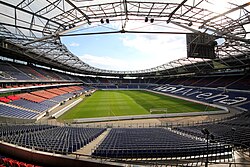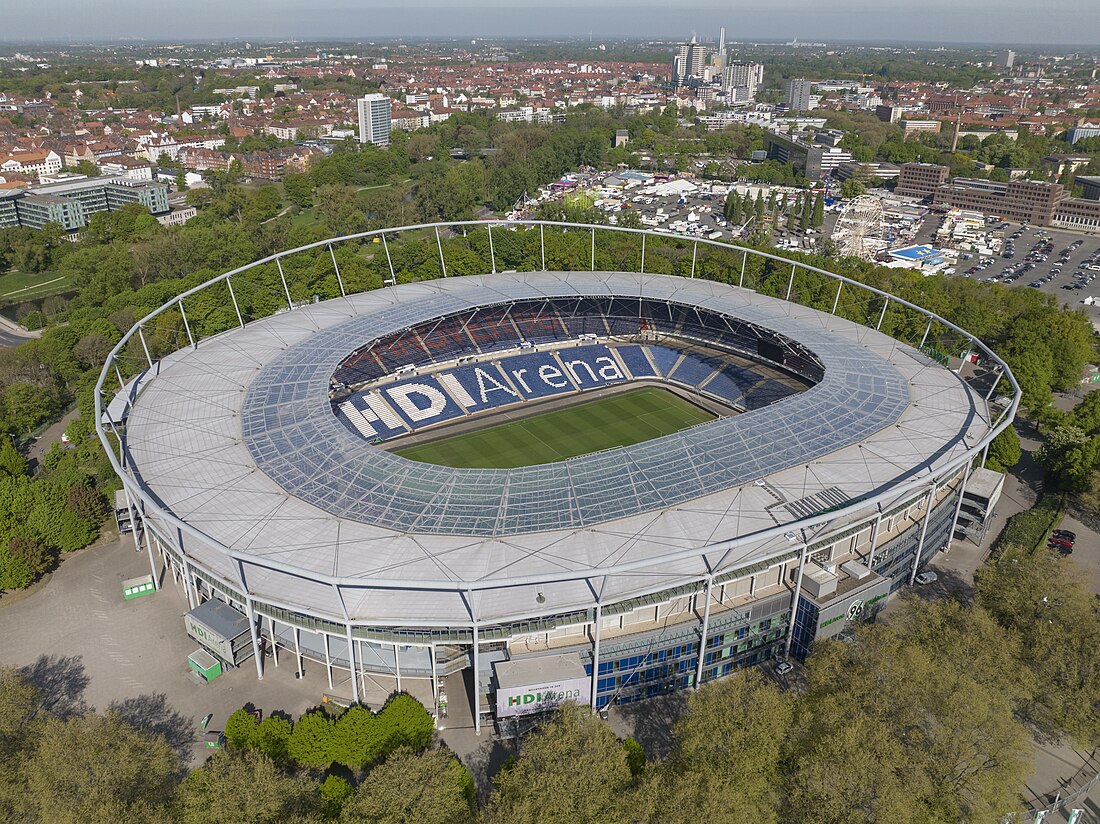Niedersachsenstadion
Football stadium in Hanover, Germany From Wikipedia, the free encyclopedia
Niedersachsenstadion (German pronunciation: [ˈniːdɐzaksn̩ˌʃtaːdi̯ɔn] ⓘ, lit. 'Lower Saxony Stadium') is a football stadium in Hanover, Lower Saxony, Germany, which is home to 2. Bundesliga football club Hannover 96.
This article needs additional citations for verification. (November 2023) |
You can help expand this article with text translated from the corresponding article in German. (June 2011) Click [show] for important translation instructions.
|
 | |
  | |
 | |
| Former names | Niedersachsenstadion (1954–2002)[citation needed] AWD-Arena (2002–2013)[citation needed] HDI-Arena (2013–2022)[citation needed] |
|---|---|
| Location | Hanover, Germany |
| Operator | Hannover 96 Arena GmbH & Co. KG |
| Capacity | 49,000[1] |
| Surface | Grass |
| Construction | |
| Opened | 26 September 1954[citation needed] |
| Construction cost | € 82.8 million (for redevelopment)[citation needed] |
| Architect | Schulitz & Partner Architects[citation needed] |
| Tenants | |
| Hannover 96 (1959–present) TSV Havelse (2021–2022) VfB Oldenburg (alternate venue, 2022–present) Germany national football team (selected matches) | |
| Website | |
| https://www.heinzvonheiden-arena.de/ | |
The original 86,000-capacity stadium was completed in 1954 and has since been rebuilt several times for various major football events. Today it has 49,000 covered seats. During the 2006 FIFA World Cup the stadium was named FIFA World Cup Stadium, Hanover.
Through a sponsorship deal, the stadium's official name is currently Heinz-von-Heiden-Arena [haɪnts fɔn ˈhaɪdn̩ʔaˌʁeːnaː]. Between 2002 and 2013 a similar arrangement saw the stadium renamed as the AWD-Arena [ˌʔaːveːˈdeːʔaˌʁeːnaː]; from 2013 to 2022 the stadium was named HDI-Arena [ˌhaːdeːˈʔiːʔaˌʁeːnaː].
History
Summarize
Perspective
The stadium was built from 1952 to 1954, with an original capacity of 86,000.[citation needed] Huge amounts of debris from the houses in Hanover destroyed during World War II were used as the foundations of the stadium, with a total construction cost of 4 million Deutschmark.[citation needed] The stadium officially opened on 26 September 1954.
Hannover 96 moved permanently to the stadium from the Eilenriedestadion in 1959.[citation needed] Other local clubs, such as Arminia Hannover, OSV Hannover, TSV Havelse and Sportfreunde Ricklingen have also played matches there.[citation needed] In addition, the stadium has hosted numerous international matches, 4 (old) league championship games (in 1955, 1957, 1958 and 1961), 2 DFB-Supercup finals (in 1991 and 1992) and 8 DFB-Pokal finals (in 1962, 1963, 1965, 1970, 1972, 1975, 1977 and 1979).
From 2002 to 2013, the stadium carried the name of financial service provider AWD.[citation needed] From 2013 to 2022, it was named after insurance company HDI.[citation needed] Since 2022, the naming rights are held by construction company Heinz von Heiden.[2]
On 17 November 2015, the stadium was due to host an international friendly between Germany and the Netherlands. However, the match was postponed two hours before kick off following reports of a "concrete security threat" and "intention to ignite explosives". The stadium and surrounding areas were evacuated, though no explosives were found.[3]
TSV Havelse played in the stadium in the 2021–22 3. Liga since their regular home stadium, the Wilhelm-Langrehr-Stadion in Garbsen, did not meet 3. Liga requirements.[4] Similarly, VfB Oldenburg will initially[vague] play their evening and winter home matches in the 2022–23 3. Liga at the stadium since their home stadium, the Marschweg-Stadion in Oldenburg, currently[when?] lacks floodlights and a heated pitch, and is bound to noise regulation ordinances for matches after 18:30. The club aims to fix these problems and move back to Oldenburg as soon as possible.[vague][5]
International football tournaments
Summarize
Perspective
All times local (CEST)
1974 FIFA World Cup
The stadium was one of the nine venues chosen for (West) Germany's first hosting of the World Cup.[citation needed] This event saw the number of seats increase to 38,000, which entailed a decrease in the overall capacity to 60,400.[citation needed] In addition, the upper rank of the west grandstand was completely roofed.[citation needed] These alterations cost 26million DM.[citation needed] Newly modified, the arena featured in both the first and second group phase.
The following games were played at the stadium during the World Cup of 1974:
| Date | Time | Team | Result | Team | Round | Attendance |
|---|---|---|---|---|---|---|
| 15 June 1974 | 16:00 | 0–2 | Group 3 | 53,000 | ||
| 19 June 1974 | 19:30 | 1–1 | 12,000 | |||
| 26 June 1974 | 19:30 | 1–0 | Group A (2nd round) | 58,463 | ||
| 30 June 1974 | 16:00 | 1–2 | 38,000 |
1988 European Championship
When Germany hosted its second international tournament, the stadium was again chosen as a venue.[citation needed] By now, due to the conversion of 8,000 terrace spots into single seating, the capacity stood at 55,000.[citation needed] It hosted two group matches:
| Date | Time | Team | Result | Team | Round | Attendance |
|---|---|---|---|---|---|---|
| 11 June 1988 | 15:30 | 2–3 | Group A | 60,366 | ||
| 15 June 1988 | 20:15 | 1–1 | Group B | 38,308 |
2006 FIFA World Cup
The stadium was one of the venues for the 2006 FIFA World Cup.[citation needed] However, due to FIFA sponsorship contracts, the arena was officially named FIFA World Cup Stadium Hanover (German: FIFA WM Stadion Hannover) during the World Cup.[citation needed] The stadium also had to convert its standing areas into seating, thus reducing the capacity for the tournament to 43,000, before being converted back after the games.
The following games were played at the stadium during the World Cup of 2006:
| Date | Time | Team | Result | Team | Round | Attendance |
|---|---|---|---|---|---|---|
| 12 June 2006 | 21:00 | 2–0 | Group E | 43,000 | ||
| 16 June 2006 | 21:00 | 0–0 | Group D | 43,000 | ||
| 20 June 2006 | 16:00 | 1–2 | Group A | 43,000 | ||
| 23 June 2006 | 21:00 | 2–0 | Group G | 43,000 | ||
| 27 June 2006 | 21:00 | 1–3 | Round of 16 | 43,000 |
Modern redevelopment
Summarize
Perspective
Although the stadium has seen many changes through the years,[vague] none were as extensive and impacting[according to whom?] as the redevelopment of 2003–04 by Schulitz & Partner Architects, which cost €65 million.
For many[quantify] years before, there had been much controversy within the club's fanbase over suggestions for building a new football arena.[vague] Eventually this led to the decision to preserve and comprehensively redevelop the existing stadium in 1997–98.[vague][citation needed] When Germany was somewhat unexpectedly[according to whom?] awarded the hosting of the 2006 FIFA World Cup, the major stadium work was finally put into action.
During 2003–04, major parts of the stadium were rebuilt; this reduced the maximum capacity to 49,951 (of which around 8,000 are standing spaces).[citation needed] Before 2003, the stadium had had high floodlight masts (referred to by locals as "toothbrushes"), track and field facilities inclusive[clarification needed] and about 60% was open plan.[citation needed] The redevelopments transformed the stadium completely into a football arena, and removed about 70% of the previous building.[clarification needed] The roof and about 25% of the area at the outer edges of the west grandstand were demolished, as were the north, south and east grandstands.
Instead of the previous scoreboards, the arena gained two modern video boards; and the old floodlight masts were replaced with 160 modern single headlights, which were integrated into the roof structure, supplying a light density of 1500 lux.
The pitch, under which a high performance[according to whom?] drainage system and a cabin ground heating system was installed, was moved closer to the spectators than ever.[citation needed] With the removal of the track and field facilities, the pitch was moved directly to the west grandstand, and the remaining grandstands were then built around it.[citation needed] This necessitated the stands behind the goals to be designed so that the upward gradient gradually increases from west to east, creating a rather peculiar[according to whom?] asymmetry, as the original west grandstand possessed such small angles of inclination and the new east grandstand was as constructed as steeply as possible.
The new inner roof was constructed using ETFE (ethylene tetrafluoroethylene) to allow sunlight through, thus allowing the grass the grow naturally, whilst also protecting all spectators from bad weather . This care for the pitch helps avoid the constant need to re-lay it, as in many other roofed stadiums, and was designed by Hanke Loköter who also helped with the construction of the Allianz Arena .
The new business and corporate packages of the AWD-Arena are just like[clarification needed] the press area in the east grandstand. There are approximately 1,250 business seats, 29 VIP boxes for 10–12 people and 96 press places.
Work on the stadium finished ahead of schedule in December 2004.[citation needed] The first football match played following the redevelopment was on 23 January 2005, when Hannover 96 lost 3–0 to Bayer Leverkusen in the Bundesliga.
In June 2008, the stadium hosted the 2008 Hannover Sevens, the European Sevens championship in rugby union.
On 15 November 2009, the stadium was filled to capacity as the funeral site for 32-year-old Hannover 96 goalkeeper Robert Enke, who had died as a result of suicide on 10 November.
The stadium is one of few actual[clarification needed][current?] stadiums to be named in FIFA 12 when it was released on 28 September 2011.
Other uses
Summarize
Perspective
Aside from football, the stadium was also the scene of several German athletics championships, the German Turnfest (a gymnastics festival), field handball finals, concerts, rugby and American football.
Since the performances of the Rolling Stones in 1982, the stadium has developed into the leading[according to whom?] open-air concert venue in Northern Germany.[citation needed] After the stadium underwent extensive redevelopment in 2003–04, the open air tradition was revived again with a concert by the Rolling Stones in the new arena.[citation needed] Madonna performed at the stadium during her Confessions Tour in August 2006 for an audience of 40,000.[citation needed] Other performers who held a concert at the venue include Michael Jackson in 1988 as part of his Bad World Tour, Bon Jovi in 1996 for his These Days Tour, Status Quo in 2006 and U2 in 2010 during their U2 360° Tour with total 56,494 audience and Kasabian as support act.
In 2013, Bruce Springsteen and the E Street Band as well as Robbie Williams are set[out of date] to give concerts for the first time at the stadium.
References
External links
Wikiwand - on
Seamless Wikipedia browsing. On steroids.
